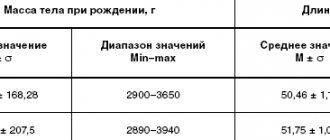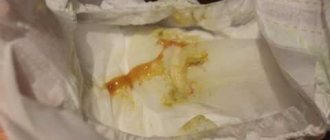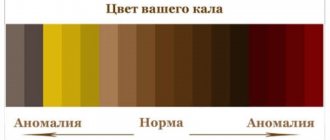How to detect blood in stool
Blood in stool leads to anemia
It often happens that blood in the stool is the only symptom that something incomprehensible is happening in the body. It is very important to pay attention and not miss the following:
- The appearance of blood streaks in the stool that look like “worms”
- Scarlet blood, which can be either on the surface of the stool or remain on toilet paper
- Loose stools with foam and blood
- The stool is liquid, and besides, it contains not only blood, but also mucus. This chair will be somewhat reminiscent of jelly.
- The stool looks like plasticine
- The stool has turned black, and this has nothing to do with eating any food
- In addition, it is worth paying special attention to when blood flows from the anus. Sometimes it's even difficult to stop her. In this case, you should definitely call an ambulance.
I will try to describe a typical baby with allergic proctocolitis.
Usually this is a well-developed, well-fed baby with excellent health, in whom, from the age of 2-3 months, parents began to notice a slight increase in stool (may or not) and streaks of scarlet blood in the stool.
Often there is also a lot of mucus in the stool.
Typically, with typical proctocolitis there is no obvious colic, but there may be restlessness when passing stool
Allergic proctocolitis can develop both in a breastfed and artificially fed child.
In a general stool analysis, you can find a large number of leukocytes in the stool (although this sign is nonspecific), and there may be a completely normal analysis.
In a general blood test, hemoglobin may be slightly reduced and the number of eosinophils may be increased, but everything may be fine.
It is with this picture that one should think about allergic proctocolitis.
Causes of Visible Blood
In most cases, blood, after it appears in the stool, can be seen with the naked eye. True, not everyone examines their bowel movements, and therefore do not always notice this manifestation. The most common reasons why blood may appear in the stool, and at the same time it will be visible, include:
- Anal fissure. Sometimes patients notice that after bowel movements they feel pain, and during it too. And if you pay attention to the feces, you can see traces of blood on its surface. This indicates that a crack has appeared. The most common cause of anal fissure is recurrent constipation, for which many people go untreated. In this case, blood may be present in the stool for several days until the wound heals. But the next time you touch it, it will start bleeding again
- Haemorrhoids. One of the most common causes of the presence of blood in the stool is hemorrhoids, which also manifests itself with other symptoms, such as itching, pain, burning, and sometimes prolapse of hemorrhoids. Hemorrhoids appear against the background of swelling of the veins, as a result of which, in severe stages, when the veins are damaged by feces, bleeding may begin. Typically the blood will be dark in color.
- Nonspecific ulcerative colitis, during which ulcerations appear on the mucosa and submucosa. In addition to the fact that there will be blood in the patient's stool, traces of pus oozing from the ulcers will also be found. Usually, a person’s well-being sharply deteriorates, he has all the signs of intoxication of the body, diarrhea, abdominal pain
- Crohn's disease, which is considered a hereditary disease, can develop as a result of measles and food allergies. In addition to blood, the stool will be loose, a skin rash, and fever will appear.
- Intestinal infections, which can be of either bacterial or viral origin. If you do not pay attention to this problem in time, blood will appear in the stool due to irritation and inflammation of the mucous membrane.
- Tumors in the intestines, both malignant and benign, which over time begin to put pressure on the blood vessels, causing them to rupture and, as a result, the appearance of blood in the stool
- Dysbacteriosis, especially when it is caused by clostridium
- Sexually transmitted infections
Depending on what caused the appearance of blood in the stool (when a person sees it independently), the treatment prescribed by a specialist will depend. Because it is very important not only to eliminate the symptoms, but also to remove the source of the problem itself.
The article, based on literature data and our own observations, presents differential diagnostic criteria for blood in the stool syndrome. We describe our own observation of a patient with Marchiafava-Miceli disease (paroxysmal nocturnal hemoglobinuria).
Syndrome blood-streaked stool at children. Clinical care of the child with the disease Marchiafawa-Michele
In the article on the basis of literature data and own observations differential-diagnostic criteria for the syndrome of blood-streaked stool is presented. Describe own observation of a patient with a disease Marchiafawa-Micheli (paroxysmal nocturnal hemoglobinuria).
The problem of gastrointestinal bleeding has long attracted the attention of pediatricians. Chronic low-intensity blood loss from the gastrointestinal tract fades into the background, at the same time slowly but surely causing damage to the child’s body. These conditions are characterized by episodic or constant symptoms of blood in the stool, the causes of which are varied and not necessarily related to proctological diseases [1].
The general principle of diagnostic measures in children with bleeding is complexity. Important information is provided by careful questioning of parents and the child when clarifying complaints and collecting anamnesis. It is necessary to strive to obtain comprehensive information about the onset of the disease, complicated by bleeding, and other features of the condition that preceded the appearance of blood in the stool. This stage of medical activity is so important that it essentially predetermines all future diagnostic and therapeutic measures [2, 3].
Bleeding from the lower gastrointestinal tract can be hidden or obvious (moderate or massive). Sometimes patients report periodic bleeding only after careful questioning. Massive intestinal bleeding, in which hypovolemia, arterial hypotension, and trachycardia are observed, is less common.
Based on the nature of blood in the stool, you can already determine the level of bleeding and its possible cause at the first stages of diagnosis. It is considered a fair rule that the brighter the blood released from the rectum, the more distal the source of bleeding is located.
Scarlet blood released in the form of drops is characteristic of damage to the rectum; streaks of scarlet blood in brown stool - with damage to the sigmoid colon; dark red blood evenly mixed with feces - when the proximal parts of the colon are affected; black tarry stools affect the small intestine and higher parts of the digestive tract [4].
If there is blood in the stool, it is important to find out whether the blood is mixed with the feces (the source is located high) or is released in a relatively unaltered form at the end of the bowel movement, which is more typical for low-lying bleeding tumors and hemorrhoids.
The nature of the disease also determines the color and amount of blood in the stool. Thus, unformed feces mixed with liquid blood of different colors, often with an admixture of mucus, indicate damage to the mucous membrane, which can accompany Crohn's disease, nonspecific ulcerative colitis or severe infectious colitis [5, 6, 7, 8, 9]. Meckel's diverticulum, bleeding tumors and polyps of the ileum, as well as high-lying hemanginomas are accompanied by a large amount of dark blood in the stool [6, 3, 10]. Accumulations of liquid blood of a dark cherry or scarlet color on the surface of the stool, usually at the end of a bowel movement, indicate the presence of a bleeding polyp in the distal parts of the colon.
Streaks of blood of a dark or bright scarlet color, traced on the surface of the stool throughout its entire length, are most often a sign of hemorrhoidal bleeding or a crack in the mucous membrane of the colon [11]. In allergic and systemic diseases, both the volume of bleeding and the qualitative characteristics of the released blood can vary significantly [12, 13, 14].
The presence of abdominal pain indicates chronic nonspecific inflammatory bowel diseases, acute ischemic lesions of the small and large intestines [15]. Sudden sharp pain in the abdomen, followed by intestinal bleeding, can be caused by intussusception of various parts, ulceration of Meckel's diverticulum [3]. Pain in the rectal area, accompanying the act of defecation or intensifying after it, is usually observed with anal fissure or hemorrhoids [11]. Painless massive intestinal bleeding can occur with intestinal diverticulosis and telangiectasias [6].
The presence of fever, arthritis, aphthous stomatitis, erythema nodosum, primary sclerosing cholangitis, eye lesions (iritis, iridocyclitis) are characteristic of chronic inflammatory bowel diseases [16]. The detection of telangiectasia on the skin and visible mucous membranes may indicate the presence of the same changes in the intestinal mucosa [17].
It should be noted that in the literature, despite a detailed presentation of the clinical picture of various causes of rectal bleeding, there is no data on the comparative characteristics of various parameters of this symptom, and the directions of differential diagnosis and the use of laboratory and instrumental methods are not discussed.
Let us illustrate the difficulty of diagnosis in the presence of intestinal bleeding with our own observation of a child with Marchiafava-Miceli disease (paroxysmal nocturnal hemoglobinuria). This disease is a relatively rare acquired form of hemolytic anemia, associated with changes in the structure of red blood cells, neutrophils and platelets, occurring with signs of intravascular hemolysis. At the genetic level, point mutations of the membrane protein gene are identified, which is manifested by a defect in the membranes of erythrocytes (Fig. 1), neutrophils, platelets and cells of erythrocyte colonies of the bone marrow [18].
Figure 1. Scanogram of red blood cells in Marchiafava-Micheli disease
1. Hypochromic erythrocyte
2. Red blood cells with a membrane defect in the form of pores
The most resistant cells in a healthy person - reticulocytes - turn out to be more fragile in Marchiafava-Micheli disease. The main role in the pathogenesis belongs to thrombotic complications due to intravascular hemolysis of red blood cells and stimulation of blood coagulation factors. The common name “paroxysmal nocturnal hemoglobinuria” does not correspond well to the essence of the disease, since with this disease there are neither real paroxysms nor obligatory hemoglobinuria [19].
The disease begins gradually. The patient complains of weakness, malaise, and dizziness. Sometimes patients notice a slight yellowness of the sclera. Often one of the first complaints is headache and abdominal pain of various locations. Hemoglobinuria is rarely the first symptom of the disease.
Intense attacks of abdominal pain are one of the characteristic signs of the disease. They are associated with thrombosis of small mesenteric vessels.
The symptom complex, including hemolytic anemia, hemosiderinuria, a positive Hem test and sucrose test, which allows identifying the increased sensitivity of erythrocytes to complement, is quite informative for the diagnosis of paroxysmal nocturnal hemoglobinuria [20]. For diagnosis at the molecular level, cytofluorometric analysis with monoclonal antibodies to membrane proteins, the expression of which is impaired in this disease, is used.
There are no pathogenetic treatments. In severe cases, bone marrow transplantation is indicated. The use of cytostatic therapy does not justify the hopes placed on it. Patients are prescribed a transfusion of washed red blood cells according to indications. In some cases, a positive effect was obtained from the use of nerabol and tocopherol. To combat thrombosis, heparin is used in small doses, as well as indirect anticoagulants.
Diagnosis of Marchiafava-Miceli disease presents a certain difficulty, especially in the initial stages of its development when abdominal syndrome dominates in the clinical picture. Here is a medical history.
Patient L., 14 years old, resident of Omsk, was admitted to the clinic with suspected Crohn's disease. Upon receipt of a complaint of abdominal pain, which is paroxysmal in nature, without clear localization. Obstetric and early medical history was unremarkable. Until the age of 10, he grew and developed in accordance with his age, and was rarely sick. From the age of ten, attacks of acute abdominal pain appeared, accompanied by repeated vomiting mixed with bile, sometimes blood, periodically with an increase in body temperature to subfebrile levels, icteric discoloration of the skin, and the appearance of dark urine. The attacks usually lasted 2-3 days and were relieved by parenteral administration of analgesics and antispasmodics. The frequency of attacks is once every two weeks. During the interictal period the boy felt well. At the age of eleven, the child was examined in the hematology department with a diagnosis of transient thrombocytopenia. The boy was repeatedly excluded from acute surgical pathology. Upon repeated examination in the gastroenterology department, a diagnosis was made: erythematous gastritis, erosive gastroduodenitis. At the age of fourteen, during one of the attacks of abdominal pain, tarry stools appeared. Due to suspicion of Meckel's diverticulum, a midline laparotomy with intestinal revision was performed. Intraoperatively, thickening of the jejunal wall and the presence of dark contents resembling blood in the lumen of the ileum were revealed. Meckel's diverticulum was excluded. During examination of the colon, no pathological formations were found. With suspicion of Crohn's disease, the boy was sent to the Nizhny Novgorod Research Institute of Pediatric Gastroenterology.
On admission the condition was of moderate severity. Physical development is normal and harmonious. The skin is pale with an earthy tint, isolated petechiae. Peripheral lymph nodes are small and elastic. The marginal icterus of the sclera was determined. Breathing and hemodynamics are not impaired. The abdomen is soft, painful in the epigastrium, pyloroduodenal zone, and left iliac region. The liver along the midclavicular line is 11 cm, palpated 3 cm from under the costal arch, dense in consistency, slightly painful, sharp edge. The spleen was not palpable. The stool is regular, well formed, without visible pathological impurities. In the blood test: Hb - 96 g/l, Er - 3.3 x 1012/l, Leuk - 4.3 x 109/l, reticular cells - 1%, segmented leukocytes - 18%, lymphocytes - 67%, monocytes - 14 %, platelets - 28‰ = 106.4 x 109/l, ESR - 26 mm/h. X-ray and endoscopic examinations of the esophagus, stomach, duodenum, colon, and terminal ileum did not reveal a source of bleeding. For the boy, Crohn's disease and ulcerative colitis were excluded.
On the 5th day of his hospital stay, he developed intense abdominal pain, and his urine was dark in color in the morning. During this period, a blood test revealed a drop in the level of hemoglobin, red blood cells, leukocytes and neutrophils (Fig. 2, 3, 4, 5).
Figure 2. Fall in hemoglobin levels during exacerbation of the disease
Figure 3. Fall in the number of red blood cells during exacerbation of the disease
Figure 4. Fall in the number of leukocytes during exacerbation of the disease
The drop in the number of neutrophils turned out to be longer and deeper, which is characteristic of this disease (Fig. 5).
Figure 5. Fall in the number of neutrophils during exacerbation of the disease
In addition, there was reticulocytosis - 57‰ (3 g - 12.2%, 4 g - 22.8%, 5 g - 65%). A urine test shows a positive reaction to hemosiderin. There is a significant number of red blood cells in the coprogram. The fecal reaction to occult blood is positive. The presence of hemolytic anemia in the child in combination with hemosiderinuria, thrombocytopenia, leukopenia, intense attacks of abdominal pain and blood in the stool syndrome served as the basis for the assumption of Marchiafava-Micheli disease. Additional studies have been conducted. Myelogram: irritation of the red germ of hematopoiesis. The Hem test is positive: hemolysis of erythrocytes - 32.56% (N up to 5%). Sucrose test for hemolysis of erythrocytes is positive: direct - 14.23% (N up to 2-3%), cross-test - negative, with the patient's erythrocytes - negative. The results of an additional study and a consultation with a hematologist confirmed that the boy had Marchiafava-Miceli disease.
This observation of a rare cause of rectal bleeding in children not associated with gastrointestinal disease indicates the need for further improvement of the diagnostic algorithm for this syndrome.
E.N. Fedulova, A.R. Bogomolov, L.N. Varnacheva, O.V. Fedorova, O.A. Tutin
Nizhny Novgorod Research Institute of Pediatric Gastroenterology
Elvira Nikolaevna Fedulova - Candidate of Medical Sciences, Head of the Department of the Clinic of Colon Pathology
Literature:
1. Lenyushkin A.I. Pediatric coloproctology. M.: Medicine, 1990. 152 p.
2. Zaprudnov A.M., Grigoriev K.P., Dronov A.F. Gastrointestinal bleeding in children. M., 1998. 208 p.
3. Zaprudnov A.M., Sadovnikov V.I., Shcherbakov P.L., Grigoriev K.I., Kvirkelia M.A. Bleeding in children with diseases of the esophagus, stomach and intestines. M., 1997. 125 p.
4. Kopeikin V.N., Obryadov V.P., Kopylov M.V. and others. Differential diagnosis of diseases occurring with blood in the stool in children: methodological recommendations. Nizhny Novgorod, 1993. 24 p.
5. Alieva E.I., Rumyantsev V.G. Crohn's disease in children. Pediatrics 2001; 6:75-79
6. Belousova I.M. Rare causes of gastrointestinal bleeding. M.: Medicine, 1976. 188 p.
7. Sheptulin A.A. Bleeding from the lower gastrointestinal tract. Russian Medical Journal 2000; 2:2:36-40.
8. Shcherbakov P.L. Inflammatory bowel diseases in children: Crohn's disease and ulcerative colitis. Children's Doctor 2000; 4:22-26.
9. Shchigoleva N.E., Rumyantsev V.G., Belmer S.V., Gasilina T.V., Karpina L.M., Kapuller L.L., Bubnova L.V. Nonspecific ulcerative colitis in children. Russian Pediatric Journal 2002; 2: 16-18.
10. Sigidin Ya.A., Guseva N.G., Ivanova M.M. Diffuse connective tissue diseases: A guide for doctors. M.: Medicine, 1994. 544 p.
11. Vorobyov G.I., Blagodarny L.A. Conservative treatment of hemorrhoids. Russian Medical Journal 2001; 9:3-4.
12. Allergic diseases in children: A guide for doctors. Ed. M.Ya. Studenikina, I.I. Balabolkina. M.: Medicine, 1998. 352 p.
13. Nasonova V.A., Astapenko M.G. Clinical rheumatology. M.: Medicine, 1989. 592 p.
14. Pytskiy V.I., Adrianova N.V., Artomasova A.V. Allergic diseases. 2nd ed., revised. and additional M.: Medicine, 1991. 368 pp.: ill.
15. Levitan B.N., Dedov A.V., Proshina P.P. Disseminated intravascular coagulation in ulcerative colitis. Russian Journal of Gastroenterology, Hepatology, Coloproctology 1999; 5: 65-67.
16. Zlatkina A.R., Belousova E.A. Extraintestinal systemic manifestations of Crohn's disease. Russian Journal of Gastroenterology, Hepatology, Coloproctology 2000; 6: 60-64.
17. Parfenov A.I., Loginov N.S. Intestinal diseases. M.: Medicine, 2000. 363 p.
18. Maschan A.A., Bogacheva N.Yu., Baydun L.V. and others. Hematology and Transfusiology 1996; 41:3:20-25.
19. Idelson L.I. Marchiafava-Miceli disease (paroxysmal nocturnal hemoglobinuria): a guide to hematology. Ed. A.I. Vorobyova. M.: Medicine, 1985. T.2. pp. 121-129.
20. Ivanova S.V., Babich N.B., Gorokhovskaya G.N. and others. Therapeutic archive 1996; 11: 73-74.
Causes of occult blood
Stool with blood is an alarming symptom
Sometimes it happens that a person cannot see blood in the stool on his own, since there are no visible traces. This usually happens when blood in the intestines and in the stool itself enters from the upper parts of the digestive system, that is, when it reaches the end, it manages to change color.
Hemoglobin, which is present in the blood, breaks down under the influence of acids, and therefore the feces literally become black. The main reasons for this phenomenon include:
- Bleeding from dilated veins in the esophagus. In addition to the fact that the stool will change color, it will also become tarry. In addition, immediately after eating a person will experience severe pain in the chest and vomit blood.
- Mallory-Weiss syndrome, in which a blood fissure forms in the esophagus or in one of the parts of the stomach. This usually happens to people who drink or those who do not treat stomach ulcers.
- Bleeding from a stomach ulcer or duodenal ulcer, when stool can be several times a day, and black in color. In addition, the person will be in pain, and the body temperature may also increase
- Perforation of a duodenal ulcer, in which the person’s condition will be as if he had lost a lot of blood, that is, dizziness, weakness, loss of consciousness. In addition, there will be blood in the stool
- Stomach cancer, especially in the later stages. It may be accompanied by other symptoms, such as weakness, anemia, aversion to any meat products
- Tumors of the esophagus, which at the moment will be in the stage of decay
- Stomatitis, both in adults and children
Due to the fact that not everyone pays attention to their stool, especially not paying attention to its color, many diseases are detected already in the last stages, when it is difficult and simply unrealistic to change something. That is why you need to be sensitive to your health and listen to your body in order to notice any changes in time and consult with a specialist about this.
Diagnosis of altered blood in stool
Blood in stool can be secretive
And if in the case of visible blood in the stool there is no need to carry out special diagnostics, since everything is already visible, then in the case of altered blood it is necessary to undergo a series of studies to make sure that it is blood and not the influence of certain food products. The most important test that allows you to determine whether there is hidden blood in the stool or not is the Gregersen test, or in other words, the Gregersen reaction.
In order to pass this test, you need to prepare. Three days before donating stool, you should not brush your teeth, eat meat or fish, or take any vitamins that contain iron. Then the person’s stool is collected, and a special mixture is applied to its surface, which allows blood to be detected.
Causes of blood in stool in children
Children are no different from adults. And if many people think that they simply cannot have some problems, then they are deeply mistaken. The child's body is absolutely the same as the adult's body. The only difference is the size of the organs. Therefore, all the reasons described above can be applied to children. However, you need to remember that mainly blood in the stool in children can appear for the following reasons:
- Intestinal dysbiosis. Today, this is one of the most common problems in children of any age, since, despite the promotion of a healthy diet and the availability of many food products specifically for children (formulas, purees, etc.), not all parents adhere to this. And there are those who feed their baby cabbage soup at six months. As a rule, dysbiosis in children appears after taking antibiotics, when a course of bifidobacteria has not been taken. To be sure that the cause of blood in the stool is dysbacteriosis, it is necessary to undergo bacterial culture tests. After the results are received, the doctor will prescribe treatment. But the most important thing is to follow the correct diet for some time and eliminate all irritating foods.
- Intestinal obstruction. One of the most dangerous reasons for the presence of blood in a child’s stool is intestinal obstruction, which occurs as a result of frequent constipation, congenital anomalies, poor nutrition, and early introduction of complementary foods. Most often, obstruction is diagnosed in children under two years of age. If we talk about the symptoms of manifestation, then immediately after eating the child will cry loudly and a lot, and then, after a while, he will simply spit up like a fountain. This symptom will also be accompanied by frequent stools with mucus and blood. But after a couple of hours, the stool will turn into a dangerous lump of mucus and blood. From this moment the most dangerous stage begins, during which, if you do not call an ambulance, the child will completely refuse water and food and fall into a state of shock.
- Food allergies. Parents often notice that their child’s skin breaks out on some food product. But sometimes allergies can be manifested by the presence of blood in the stool, as well as foamy stools. As a rule, such a manifestation can occur when a child consumes milk, citrus fruits, and various food additives.
If there is a suspicion of one of the above reasons, or in general the child has stool in the blood, it is necessary to visit a doctor as soon as possible so that he can determine the cause and prescribe treatment.
Treatment of causes of bloody stools in children
After taking tests and identifying the cause of bleeding in the child’s stool, the doctor gives recommendations or prescribes specialized treatment. In case of blood in the stool caused by an allergic reaction to milk protein, it is recommended that nursing mothers exclude dairy products from the diet (for a couple of weeks), and artificially fed mothers should use mixtures with split protein in their diet. If a baby's pathology is caused by cracks in the mother's nipples, the doctor will recommend mastering the rules of feeding techniques. Treatment of more serious causes of bloody stool in a child should be strictly under the supervision of a doctor.
Medicines and methods
In case of dysbacteriosis with bloody stools and any infection caused by viruses or bacteria, careful selection of antibiotic and antimicrobial agents is required. In order not to provoke increased bleeding, you need to take medications strictly as prescribed by a specialist and in the quantities that he prescribes. Doctors often recommend a course of “Bactrim” or “Vancomycin” for dysbiosis and “Arbidol”, “Viferon” for a viral infection.
For an anal fissure caused by constipation, the child is prescribed a gentle diet, osmotic drugs that block calcium channels and ointments with a nitroglycerin base.
If neoplasms are detected in the large intestine, drugs are prescribed to inhibit the growth and development of polyps. However, more often the problem is solved radically, by surgical intervention, because neoplasms may be malignant.
When a colony of helminths is detected, drugs with the properties of suppressing the nervous system of parasites are used - “Tinidazole”, “Metronidazole”.
For congenital intestinal pathologies, therapy is used in a hospital setting using a procedure to straighten the intestines with a device that pumps air. Or a surgical method is used - laparoscopy.
Folk remedies
Traditional medicine can only be used in treating the causes of bloody stools in addition to medications. If the cause of the pathology is the baby's frequent constipation, warm baths are taken with a solution of potassium permanganate or chamomile decoction. The decoction promotes rapid healing of anal fissures and relieves inflammation. You can make a microenema with a decoction of chestnut bark.
For bloody discharge associated with diarrhea, infusions are excellent antiseptics:
- peppermint, snakeweed (rhizomes), blueberries, chamomile - 1 tbsp. Brew a spoon in half a liter of boiling water, leave for 30 - 40 minutes. For a school-age child, you can give half a glass 30 minutes before meals, 3 times a day.
- Brew pomegranate peel (1 teaspoon) in 250 ml of water, simmer over low heat for 15 minutes, leave in a warm place (1.5 - 2 hours), strain. A child is recommended 1 tbsp. a spoonful of infusion 3 times half an hour before meals, for children - one teaspoon.
A good auxiliary agent is starch: dissolve 1 tbsp in a glass of water at room temperature. spoon of potato starch. For a child, half a glass 2 times a day is enough. For the little ones, you can brew and slightly sweeten the jelly. It is important for parents to remember that traces of blood in the stool are a serious cause for concern.
When to call an ambulance
Bloody feces are a symptom of various diseases
There are a number of cases, both with adults and children, when when blood appears in the stool, it is necessary to urgently call an ambulance. Such cases include:
- Frequent loose stools, especially in children, because dehydration may develop. And if a child loses 10 to 20 percent of fluid, this can be fatal
- Frequent vomiting, which is also dangerous for children. But even in the case of adults, if you cannot stop it, it is better to call an ambulance
- High body temperature, especially when it cannot be brought down for a long period of time
- Severe pain in the abdominal area, such that the person begins to lose consciousness
- Vomiting blood
Sometimes an ambulance can give several injections on the spot, administering the necessary drugs, and leave. But in the case of children, they usually offer to go to the hospital, which in no case should be refused. Because in the hospital, with the help of medications and IVs, the child will quickly be brought back to normal. In addition, he will be under the constant supervision of qualified doctors who can provide assistance at the right time.
Many people immediately become concerned if they see blood in their stool. And this is a normal reaction, because blood cannot appear here just like that. This is one of the important and often the main symptoms of bleeding caused by destructive processes in the intestines that need to be treated, and the sooner the better.
Associated symptoms
If a child develops loose stool mixed with blood, it is necessary to determine other accompanying symptoms. This will help in the future to describe to the doctor a complete picture of the baby’s condition and provide him with full assistance.
Body temperature
If a child’s usual stool is replaced by diarrhea with blood without fever, this may be evidence of:
- allergic reaction;
- indigestion after overeating;
- a sudden change in the usual diet;
- early incorrect introduction of complementary foods;
- severe stress, fear;
- mild food poisoning.
However, such a disorder can also be caused by more serious reasons. Therefore, the appearance of even minor blood impurities in the stool is a good reason to consult a doctor.
Vomiting and diarrhea with blood in a child with a fever is the first sign of an acute intestinal infection. Such symptoms are usually accompanied by weakness, dizziness, body aches, pain, rumbling and cramps in the abdomen, and a false urge to defecate.
Change in color of stool, presence of mucus
If the disorder develops, you should take a very close look at the stool. Sometimes parents mistake incompletely digested red foods (tomatoes, beets, paprika, blueberries, currants, etc.) for blood streaks.
The most dangerous condition that requires immediate medical attention is red diarrhea in children. The appearance of scarlet blood can mean rapid massive hemorrhage in the colon or other parts of the intestine.
The presence of liquid stool that is dark brown or black in color (so-called melena) indicates the presence of a source of bleeding in the upper gastrointestinal tract or inflammatory changes in the walls of the small intestine.
Foamy yellow-green, greenish, light brown and other colors of diarrhea in a child with streaks of blood and mucus usually develops against the background of an acute intestinal infection.
Anal itching
If bloody diarrhea in a child is accompanied by itching in the anus, this may be evidence of injury to the internal hemorrhoid.









